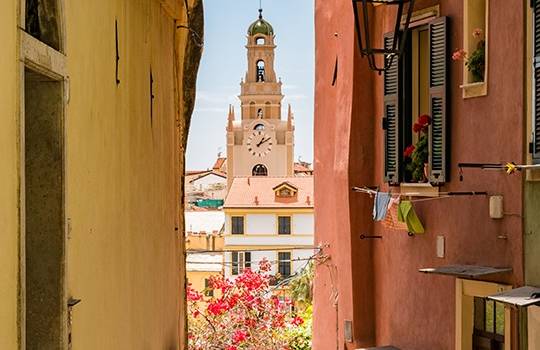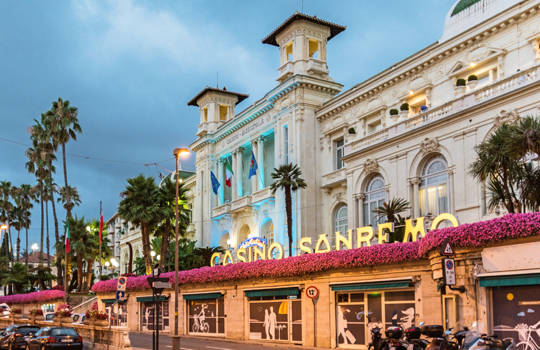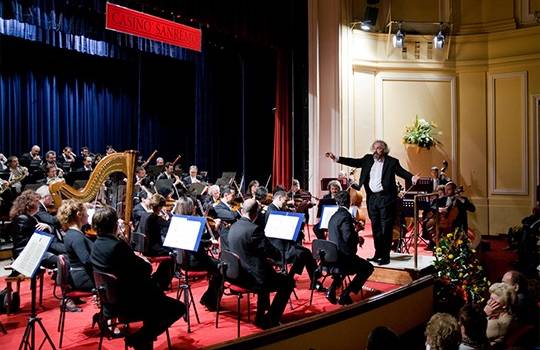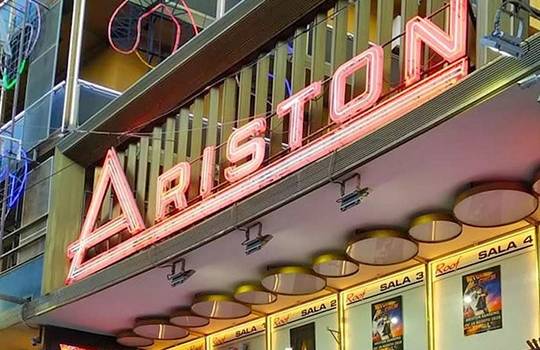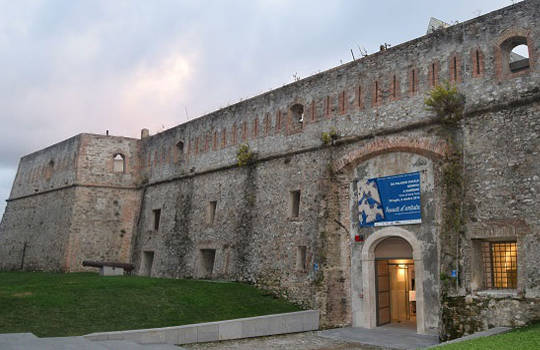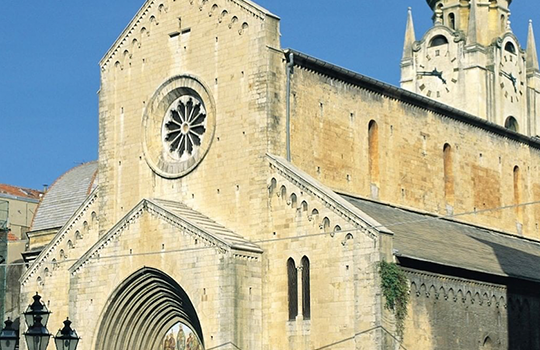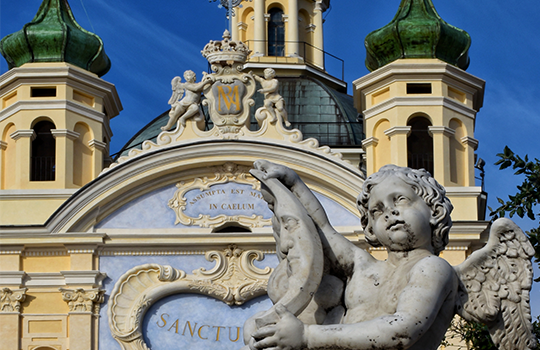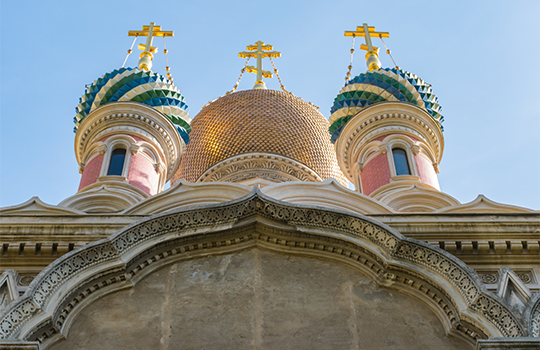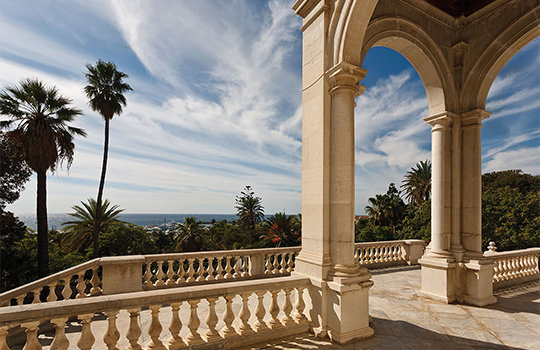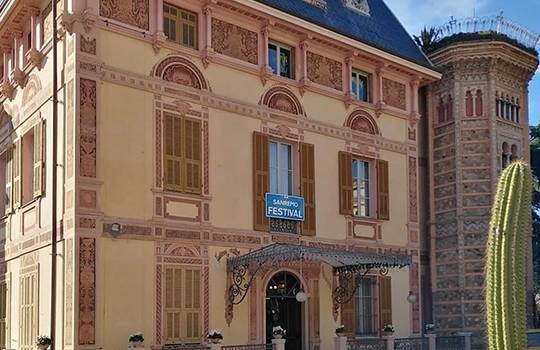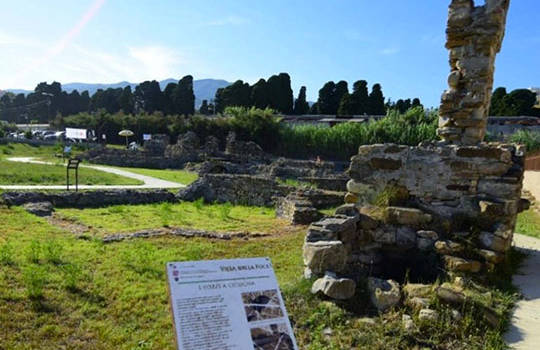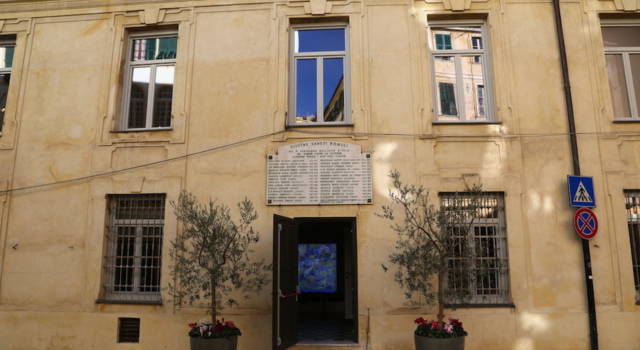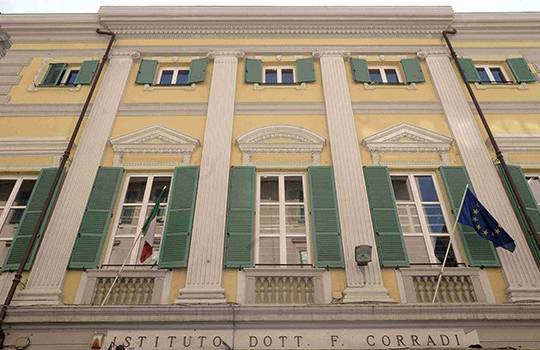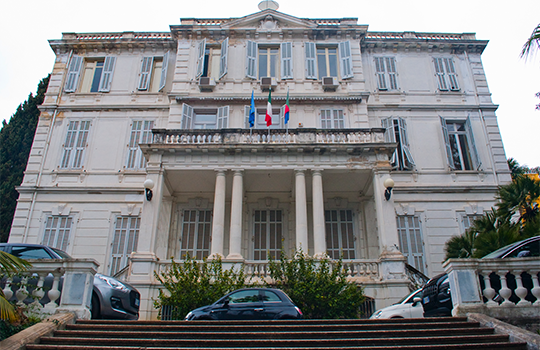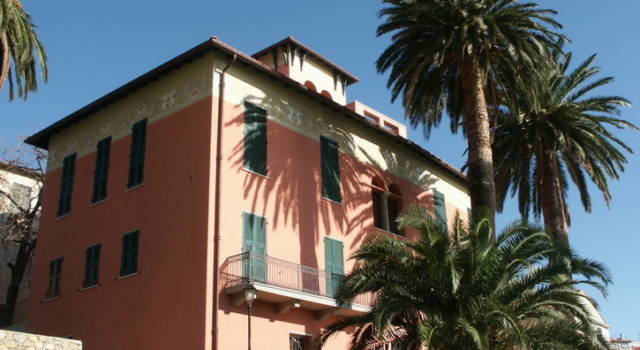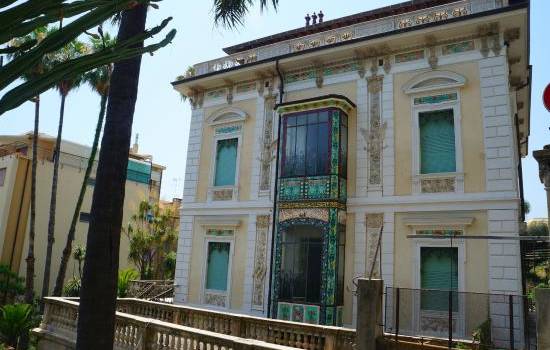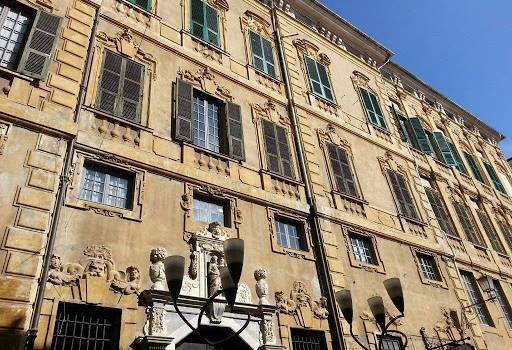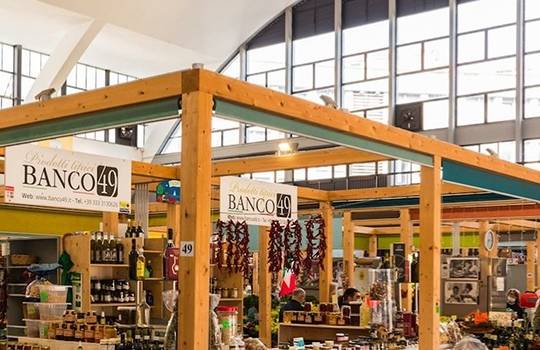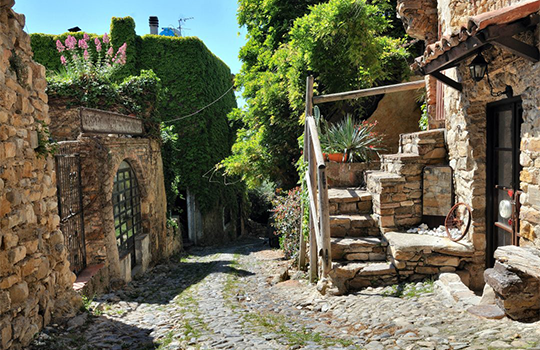
Traditions and culture
La Pigna
With its closely built buildings and narrow streets (caruggi) that get lost one inside the other, the historic centre is the symbol of the traditions and strength of Sanremo’s past history. In fact, it is impossible to really know the town without visiting La Pigna, that owes its name to its self-protective shape, which resembles a pine cone. The first settlements date back to around 1000 A.D., but La Pigna was fortified and enlarged for centuries to protect it from external invasions. From the highest windows, the sea could be seen so that the alarm could be raised quickly in case of danger. And still today La Pigna silently dominates the city, preserving its charm…
Casinó Theatre
Designed by French architect Eugène Ferret, the Casino was inaugurated on 12th January 1905 under the name Kursal. Created to provide an indoor leisure venue for foreign guests, it has hosted parties and shows for the first two years, but gambling was also practised, although without any official authorisation. It was not until 22nd December 1927 that a decree issued by Benito Mussolini officially sanctioned the birth of the Sanremo Casino. Over the years, the elegant halls of the Casino have hosted many personalities from the national and international jet set, who have alternated at the green tables, engaging in memorable challenges. To mention one of them, King Faruk, who in the 1950s was one of the most frequent visitors to the Sanremo Casino, after his exile from Egypt. Also regulars were Oscar-winning actor and director Vittorio De Sica, an inveterate gambler, King Gustav of Sweden, King Leopold of Belgium, Ranieri and Grace of Monaco. Alongside gambling, the Casino carried on a rich cultural activity, benefitting from the collaboration of consultants such as the poet Francesco Pastonchi who inaugurated the tradition of literary Mondays (now Tuesdays), the musician Pietro Mascagni and Luigi Pirandello. The Sanremo Casino was also the first “home” of the Sanremo Festival: in 1951, its elegant halls were the starting point for what would have become Italy’s most iconic singing event.
SCOPRI DI PIÚ →
Sanremo Symphony Orchestra
The Sanremo Symphony Orchestra Foundation, founded in 1095, is undoubtedly one of the oldest and most prestigious Italian musical institutions, and on of twelve Government recognized C.O.I. Orchestras (Concert and Orchestra Institutions). In its long history, it has hosted some of the greatest conductors and international soloists. Attentive to the promotion of young talents, the Sinfonica is characterized by a great versatility that allows the orchestra to perform, always with great recognition, both the classical and the romantic, modern and contemporary repertoire. Since 2003, the orchestra’s teachers have taken part in the Sanremo Festival, accompanying the artists in the competitions and the guests.
SCOPRI DI PIÚ →
Ariston Theatre
This is where dreams are born… Let’s face it, we’ve all dreamed of stepping onto the Ariston stage like a star at least once. The legendary Ariston Theatre is undoubtedly one of Sanremo’s most iconic venues. Located in the central Via Matteotti, it has been hosting the Sanremo Festival since 1977 and it is visited every year by the greatest national and international artists. Designed in the 1940s and inaugurated in 1953, the Ariston is not only a prestigious theatre but also a cinema. During the year it hosts numerous events such as the Tenco Prize and various programmes broadcast on Rai channels. The theatre management also organises guided tours to discover the secrets of the theatre and the Festival’s history.
Forte Santa Tecla
First a symbol of Genoese strength against the “rebel Sanremese“, then a stronghold defending against the invasions by sea, it then became a barracks, a city prison and finally the city’s main museum. In its almost 270 years of life, Forte di Santa Tecla has undoubtedly played a leading role in local history, changing its “skin” several times, but always remaining one of the city’s symbols. “Dominating” of the old port, it is one of the few remaining examples of 18th-century Ligurian military architecture. The building had 16 pieces of artillery, arranged on front bastions and another 5 smaller ones on the rear bastion. It was built by the Republic of Genoa after the popular uprising of the people of San Remo in 1753. During the Napoleonic period, the Fort played its defensive and protective role on the coast. After 1815, when Liguria became part of the Kingdom of Sardinia, it was used as barracks and from 1864 to 1997 as the city prison. After the important work carried out by the Superintendency of Architectural Heritage, in 2016 the Fort of Santa Tecla was returned to the city, becoming a venue for exhibitions and cultural events.
San Siro Co-cathedral
The Co-cathedral of San Siro is the oldest religious building in the city. The façade, a marvellous example of late Romanesque style, has returned to its former glory thanks to a major restoration project. The co-cathedral is one of Sanremo’s citizens’ most beloved symbols: over the centuries and in difficult times they have often gathered in its naves. It is said that in August 1543, on the eve of a battle with the Saracens, the black crucifix, which still located on the altar, lit up, “predicting” victory against the invaders. The battle went down in history as the “Battle of Parà”.
Madonna della Costa
When visiting Sanremo, you should not miss the magnificent view from the sanctuary of the Madonna della Costa, which overlooks La Pigna, our historic centre, from the hill. Its position allows you to see the city of flowers in all its beauty and to enjoy a unique view. The present structure (built on the site of a previous Marian chapel) was constructed in 1630. The façade is a wonderful example of Baroque style. The large churchyard has a characteristic mosaic pavement, in typical Ligurian style. According to the tradition, the Sanctuary recalls how the people of Sanremo celebrated the “feast of chains” by dragging chains up to the Sanctuary to celebrate the liberation from the Dorias of 1361.
LEGGI ANCHE →
The Russian Church
During your stay in Sanremo, don’t forget to visit the Russian Church. Located a few steps away from the Casino and the beaches, it was built to meet the needs of the many Russian tourists who used to live in Sanremo at the beginning of the 20th century. The symbol of the building are the magnificent five bulbous domes (recently returned to their original splendour after a careful restoration) that majestically dominate the Promenade “Imperatrice” dedicated to Tsarina Maria Aleksandrovna. The church still belongs to the Western European Diocese of the Orthodox Church and is open to the public.
SCOPRI DI PIU →
Villa Ormond
Villa Ormond is one of Sanremo’s most elegant and historically rich residences. Built at the end of the XIX century by the homonymous Swiss businessman, from a design by architect Emile Reverdin, the spacious rooms, with their polychrome coffered ceilings, have hosted the elite of the European aristocracy, such as the Princes of Prussia, the Duke of Aosta and Empress Elisabeth of Austria. But the real jewel in the crown is the park, where exotic and rare plants have found a home, and you can admire a traditional Japanese garden. In 1930, the villa was purchased by the municipality and the park “given” to the citizens. Today, Villa Ormond (home to the International Institute of Humanitarian Law) is the perfect venue for events.
Villa Nobel
Did you know that the Nobel Prize was established in San Remo? The homonymous Swedish scientist fell in love with the city of flowers and the marvellous XIX-century Moorish-style villa, built in 1870 to a design by Filippo Grossi. Alfred Nobel bought the villa in 1891 and lived there, where he continued his studies until his death in 1896. On 27th November 1895, he signed his famous will and funded the prestigious prize dedicated to scientific and literary research. Inside the villa, a copy of the document is on display: it is part of the museum’s documentation on the inventor’s life and discoveries. The reproduction of the study where the original collection of scientific instruments and equipment is kept is particularly interesting. In the marvellous park, over 6000 square metres in size, there is still the monumental cannon made by Bofors that Nobel used in his experiments on firearms.
Villa Matutia
The Villa Romana or Villa Matutia is an important archaeological site from Roman times. The residence (located in the Foce neighbourhood near the monumental cemetery) was built around the I and II centuries AD and stood out for its luxury and beauty: we can still admire the remains of the thermal complex the villa was equipped with, such as the ovens outside the rooms, the hot air circulation ducts and the large apsidal pool for hot baths.
Palazzo Nota
The civic museum is housed in the XVII century Palazzo Nota. The building was designed by the architect Pietro Antonio Corradi, who also designed large buildings in Genoa, including Palazzo Rosso. Before housing the civic museum, Palazzo Nota has been for centuries at the centre of Sanremo’s political life: in 1687 it became the seat of the Commissioner General of the Republic of Genoa, and from 1794 until 1963 it housed the offices of the Sanremo Town Council. The archaeological section is located on the first floor; there are preserved the most ancient testimonies of the Sanremo territory since prehistoric times. It includes a prehistoric section with Palaeolithic finds from the Arma and Via S. Francesco caves; Eneolithic, Bronze Age and Iron Age materials from the Sanremo area and Argentina valley, as well as a Roman archaeological section with finds from necropolis and the Roman villas of Foce and Bussana. On the upper floors is located the art gallery with paintings from the XVII to the XIX century, including “Coronation of Saint Catherine of Alexandria between Saints Margaret and Apollonia” by Pieter Paul Rubens. Of considerable interest is the section dedicated to Giuseppe Garibaldi. The highlight is the room dedicated to Antonio Rubino, corriere dei Piccoli’s beloved illustrator and native of Sanremo; the room includes paintings, miniature theatres, ink drawings, sketches and many other works characterised by his unmistakable style.
The Public Library
With a collection of more than 130,000 books that is constantly expanding and evolving, Francesco Corradi Public Library is one of the most important cultural centres in the city. Located in the city centre in a 19th century building, it is named after the benefactor who donated his book collection to the city. Particular attention is paid to the children’s section, to which the “Antonio Rubino” room is dedicated, with over 6,000 volumes and venue of numerous workshops and activities for children. The library also “hosts” numerous precious “funds”. One of them belonged to the Capuchin friars and contains manuscripts and works from the XVI, XVII and XVIII centuries; another one is that of Mario Calvino and Eva Mameli Calvino, parents of the writer Italo Calvino, who lived and worked in Sanremo as botanists and researchers. A section is entirely dedicated to Italo Calvino: it hosts the author’s writings and a collection of Italian and foreign critical writings. The “Bartolomeo Asquasciati” mountaineering collection is also of particular interest, as is the one dedicated to “Renzo Laurano”, consisting of about 4,500 volumes and a small, but precious, collection belonging to the English poetess Caroline Giffard Phillipson, one of Garibaldi’s friends.
Villa Zirio
Villa Zirio owes its name to its first patron, Cavalier Giovan Battista Zirio, a banker from Marseilles. He had the villa built in 1868 so that he could live there with his wife Marie Grandval during their stays in their home town. The French architect Bérengier was commissioned to build the villa. He designed a neoclassical building with a double semi-circular staircase leading up to the central colonnaded loggia supporting the terrace on the second floor. Villa Zirio currently houses some municipal offices and the headquarters of the Symphony Orchestra. The villa’s slightly sloping garden was created by the famous Ludwig Winter, a German botanist and landscape architect, designer of garden centres and gardens such as those in Bordighera and Hanbury in La Mortola.
Villa Luca
Located in the heart of Coldirodi, a hamlet on the heights of Sanremo, the XIX-century Villa Luca is home to the Rambaldi Art Gallery. Established in 1865 thanks to the bequest of the priest Paolo Stefano Rambaldi, the art gallery includes a precious collection of paintings and antique books. The painting collection consists of 100 works dating from the 15th to the 19th century, including the Madonna and Child, attributed to Lorenzo di Credi (Verrocchio’s workshop), Frà Bartolomeo della Porta’s Holy Family, as well as valuable paintings by Aurelio Lomi, Salvator Rosa, Michele Rocca, Jacopo Ligozzi and numerous examples of the major Italian schools of painting. The library contains more than 5000 books (including precious testimonies such as a copy of “Pliny’s Historia naturalis”, published in 1476, a 1480 Latin Bible by Renner and Titus Livius’ 1470 “Historiae romanae decas”) and a collection of letters between Rambaldi and numerous exponents of Italian culture. The collection is perfectly integrated in the marvellous mansion’s rooms, which is frescoed by Morscio. You don’t want to miss out on the view on the bay from Villa Luca’s gardens.
SCOPRI DI PIÚ →
Villa Angerer
A masterpiece of Art Nouveau architecture just a few steps away from the Casino, Villa Angerer owes its name to the Austrian lawyer Leopold Angerer, who bought it and completely renovated it at the end of the XIX century. The residence is a tribute to art nouveau, which is omnipresent in every detail and decoration, often characterised by floral and naturalistic motifs and the masterful use of glass and wrought iron. The main windows are particularly precious: they were transformed during the renovation into bow windows, or so-called balconies, closed in one with a decorated glass. The villa is surrounded by a park. The heart of the garden contains a very rare specimen of Wollemia nobilis, a tropical plant of which exist very few examples in the world. The Angerer family lived in the villa until 1937, which has been owned by the municipality since 1991.
Palazzo Borea d'Olmo
It dominates the central Via Matteotti with its imposing and severe Baroque façade: Palazzo Borea D’Olmo is one of the most famous and fascinating historical residences in the history of Sanremo. For years house of the town’s civic museum, the building was built around the XV century, and took on its current appearance during the Baroque era, between the XVII and XVIII centuries. The building has been continuously inhabited by members of the Borea d’Olmo family, of Venetian origin and ancient lineage, who chose it as their home and to whom it owes its name. Palazzo Borea D’Olmo has for centuries been at the heart of local history and beyond: its rooms have hosted numerous illustrious guests such as Queen Elizabeth of Spain, King Charles Emmanuel III, Prince Philip of Edinburgh and Pope Pius VII. An anecdote is linked to the Pope’s brief stay here in 1814: some devout religious people unsuccessfully attempted to take possession of the furnishings and objects used by the Holy Father.
Farmers Market
Sanremo’s food market is the centre of local food and wine excellence. Recently renovated, it houses numerous stalls selling fresh fruits and vegetables as well as a cheerful array of shops such as bakeries, butchers, delicatessens, household products and much more. There is also an area dedicated to typical products and self-employed farmers. Next to the market is the fish market, where you can find the best fish every day.
Bussana
On Sanremo’s hills there is a small village inhabited by a lively community of Italian and international artists. Bussana vecchia, is a little pearl that dominates the eastern beaches from above. The village, whose first permanent settlements date back to the VII century AD, was almost completely destroyed by a violent earthquake in 1887. For years, Bussana was uninhabited until a few artists and craftsmen began to settle there at the end of the 1950s. They brought the village to life again. Today Bussana vecchia is a small wonder to be discovered by walking through the narrow streets where artists exhibit their works. Be sure to visit the remains of the church of Sant’Egidio and its bell tower, which has miraculously escaped the earthquake and has become the symbol of the village.
